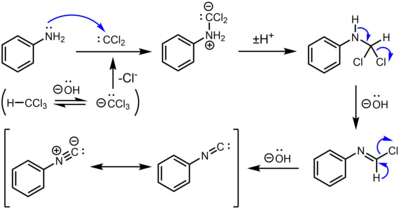
Which one of the following compounds when heated with KOH and a primary amine gives carbylamine test ?
A \[\text{CHC}{{\text{l}}_{\text{3}}}\]
B \[\text{C}{{\text{H}}_{\text{3}}}\text{Cl}\]
C \[\text{C}{{\text{H}}_{\text{3}}}\text{OH}\]
D \[\text{C}{{\text{H}}_{\text{3}}}\text{CN}\]
Answer
221.1k+ views
Hint: Potassium hydroxide, sometimes known as caustic potash, is an inorganic chemical with the formula KOH. KOH is a typical strong base, along with sodium hydroxide (NaOH). It has numerous industrial and specialised uses, the majority of which make use of its caustic properties and acid reactivity.
Complete solution step by step:
The intermediate produced by the dehydrohalogenation of chloroform receives amine in the carbylamine reaction process. The name of this intermediary is dichlorocarbene. The Hofmann isocyanide synthesis is another name for the carbylamine reaction. Isocyanides are created through the reaction of a primary amine, chloroform, and a base. For this reaction, the dichlorocarbene intermediate is crucial. It is impossible to create isocyanides from secondary or tertiary amines via the carbylamine reaction. The carbylamine reaction can generally be expressed as –
\[R-N{{H}_{2}}~+\text{ }CHC{{l}_{3~}}+\text{ }3KOH\text{ }\to \text{ }RNC\text{ }\left( \text{Carbylamine} \right)\text{ }+\text{ }3KCl\text{ }+\text{ }3{{H}_{2}}O\]
The carbylamine reaction can be used as a chemical test because it only works for primary amines. The response is often referred to as Saytzeff's isocyanide test in this situation. In this process, chloroform and alcoholic potassium hydroxide are used to heat the analyte. The isocyanide (carbylamine) is generated when a primary amine is present, as shown by an unpleasant odour. With secondary and tertiary amines, the carbylamine test does not produce a positive result.
Mechanism
The procedure entails mixing amine with dichlorocarbene, a reactive intermediate produced by chloroform's dehydrohalogenation. The isocyanide is created by two sequential base-mediated dehydrochlorination processes.

Hence option a is correct .
Note: The carbylamine reaction can be used as a chemical test for the presence of primary amines because it only reacts with primary amines. The carbylamine reaction is also known as the Hofmann's isocyanide test when used as a test. In this experiment, chloroform and alcoholic potassium hydroxide are used to heat the test material. When primary amine is present, isocyanide (carbylamine) will develop and emit an exceedingly unpleasant odour, making it easy to detect. Since secondary and tertiary amines do not experience the carbylamine reaction, they do not produce an unpleasant smell when tested with Hofmann isocyanide.
Complete solution step by step:
The intermediate produced by the dehydrohalogenation of chloroform receives amine in the carbylamine reaction process. The name of this intermediary is dichlorocarbene. The Hofmann isocyanide synthesis is another name for the carbylamine reaction. Isocyanides are created through the reaction of a primary amine, chloroform, and a base. For this reaction, the dichlorocarbene intermediate is crucial. It is impossible to create isocyanides from secondary or tertiary amines via the carbylamine reaction. The carbylamine reaction can generally be expressed as –
\[R-N{{H}_{2}}~+\text{ }CHC{{l}_{3~}}+\text{ }3KOH\text{ }\to \text{ }RNC\text{ }\left( \text{Carbylamine} \right)\text{ }+\text{ }3KCl\text{ }+\text{ }3{{H}_{2}}O\]
The carbylamine reaction can be used as a chemical test because it only works for primary amines. The response is often referred to as Saytzeff's isocyanide test in this situation. In this process, chloroform and alcoholic potassium hydroxide are used to heat the analyte. The isocyanide (carbylamine) is generated when a primary amine is present, as shown by an unpleasant odour. With secondary and tertiary amines, the carbylamine test does not produce a positive result.
Mechanism
The procedure entails mixing amine with dichlorocarbene, a reactive intermediate produced by chloroform's dehydrohalogenation. The isocyanide is created by two sequential base-mediated dehydrochlorination processes.

Hence option a is correct .
Note: The carbylamine reaction can be used as a chemical test for the presence of primary amines because it only reacts with primary amines. The carbylamine reaction is also known as the Hofmann's isocyanide test when used as a test. In this experiment, chloroform and alcoholic potassium hydroxide are used to heat the test material. When primary amine is present, isocyanide (carbylamine) will develop and emit an exceedingly unpleasant odour, making it easy to detect. Since secondary and tertiary amines do not experience the carbylamine reaction, they do not produce an unpleasant smell when tested with Hofmann isocyanide.
Recently Updated Pages
Difference Between Alcohol and Phenol: Structure, Tests & Uses

Classification of Drugs in Chemistry: Types, Examples & Exam Guide

Class 12 Chemistry Mock Test Series for JEE Main – Free Online Practice

Is PPh3 a strong ligand class 12 chemistry JEE_Main

Full name of DDT is A 111trichloro22bispchlorophenyl class 12 chemistry JEE_Main

Sodium acetate on heating with soda lime produce A class 12 chemistry JEE_Main

Trending doubts
Understanding Atomic Structure for Beginners

Understanding Entropy Changes in Different Processes

Common Ion Effect: Concept, Applications, and Problem-Solving

What Are Elastic Collisions in One Dimension?

Free Radical Substitution and Its Stepwise Mechanism

Understanding Geostationary and Geosynchronous Satellites

Other Pages
NCERT Solutions For Class 12 Chemistry Chapter 9 Amines

Test for Phenolic Group

JEE Advanced 2026 Revision Notes for Practical Organic Chemistry

NCERT Solutions for Class 12 Chemistry Chapter 2 Electrochemistry

Convert chloro benzene to phenol class 12 chemistry JEE_Main

NCERT Solutions For Class 12 Chemistry Chapter 10 Biomolecules - 2025-26




